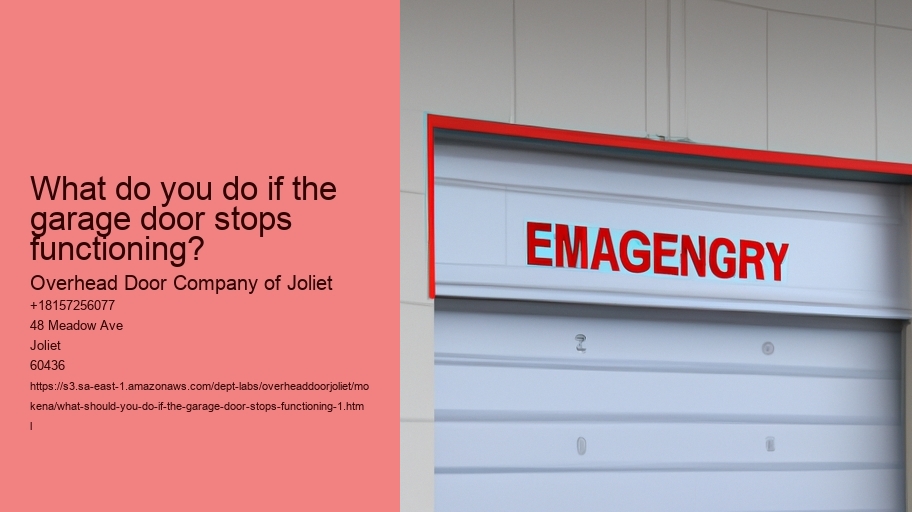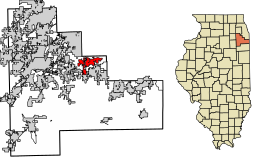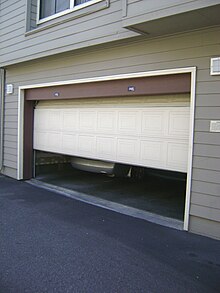Know the type of garage Door and Opener
If garage doors suddenly stop functioning, it could be a stressful and uncomfortable experience.Whether you're hurrying to work, or trying to pull your car to the garage in the middle of a storm and the door stops working, it's the last thing you want to have to deal with.The first step in dealing with this issue is to recognize the type of opener and garage door that you have as it will drastically affect your strategy for fixing and troubleshooting. What is the most important thing You Should Do When Your Garage Door Suddenly Stops Working? .
Garage doors are generally classified into different categories based on their design and operation.The most frequent types are sectional, roll-up as well as tilt-up doors.Sectional doorways are constructed from panels joined by hinges, allowing the door to bend when it opens and closes on the vertical track.Roll-up doors, which are typically found in commercial environments are made from sections of wood that are rolled up into a coil.
Tilt-up doors, on the contrary are a single piece that tilts out and up as it opens.Also important is knowing the kind of garage door opener.The three main types are chain-drive, belt-drive, and screw-drive openers.Chain-drive openers, which use chains of metal to raise and lower the door, are strong and cost-effective, but they can also be noisy.Belt-drive openers function similarly, however, they employ a rubber belt which makes them quieter and a good choice for attached garages.Screw-drive openers are able to move the door by means of a threaded steel rod providing a compromise between the noise and the cost.
Once you've identified your garage door's opener type then the next step is to perform simple checks for common issues.Ensure that power is connected to the opener by checking the plug as well as the breaker.Inspect the manual release cord to make sure that it isn't pulled, which would disconnect the door from the opener.Examine the tracks of the door and rollers for obstructions or damages and remove any debris.
Lubricate moving parts if necessary since a lack of lubrication could cause jamming or sticking.Resetting your opener can resolve any electronic faults. Consult the manual of the model you are using to determine the precise steps. Some openers are reset with a push of an icon, while other require that the unit be unplugged and then re-plugged.
What should you do if the garage door stops functioning? - electrical connector
- technician
- electrical connector
- wall
The tension of springs is very high, and it can be hazardous to repair them if you don't have the proper tools.
In the end, if the garage door stops working, the
Examine for obstructions and debris
When the garage door abruptly stops functioning, it can be difficult and frustrating, especially if it's a part of your routine.
This easy but powerful step can be used to pinpoint the issue and bring back functionality to your garage. Even a small obstruction could prevent your garage door from functioning properly.
What should you do if the garage door stops functioning? - wall
- United States of America
- hammer
- Iowa
Begin by visually examining the tracks that run along both sides of the door.Look for obvious obstructions, or the buildup of debris.If you spot anything odd like stones or a twig stuck in the track make sure you remove it.
There are times when the problem might not be evident immediately It is recommended to run your hand across the track to look for any hidden obstacles.Ensure that the tracks are properly aligned as well, as any misalignment could result in the door becoming jammed.The next step is to inspect the rollers and hinges.These parts should move freely without resistance.If they're sloppy or stuck, it could be an indication of accumulated grime or rust.In the event of such a situation cleaning and lubricating them can often resolve the issue.Use a soft brush or cloth to wipe away any dirt, and apply a suitable oil to make sure that the parts move smoothly.
It's also vital to look over the area surrounding the door itself.Sometimes items that are stored in the garage could accidentally slide or shift, obstructing the path of the door.Ensure that the area is free of obstructions and nothing is blocking the door's motion.
Verify the sensors if the door doesn't open after you have removed any obstructions.
Modern garage doors are fitted with security sensors that will stop the door from closing in case anything is detected within the path.Make sure that the sensors are in good condition and aligned properly, since dirt or misalignment can cause them to malfunction.By maintaining a clean path and clearing out obstructions, you'll stay clear of having to call a professional solve a problem which is usually simple.
Verify the wall switch as well as the remote control
It's essential to inspect the wall switch and remote control.
Checking these components can help you to save time and avoid costly errors.First, consider the remote control.This handheld device is your primary tool for operating the garage door without direct physical interaction.Over time, remote controls can experience issues such as drained batteries, signal interference, or even internal damage.Start by replacing the batteries with new ones.It might seem simple, but dead batteries are a common reason for a garage door not responding.If the problem persists after replacing the batteries, try reprogramming the remote according to the manufacturer's instructions.Additionally, ensure that the remote is within the recommended range and that there are no obstructions blocking the signal.
Then, shift your focus towards the wall switch. It is also a crucial component of the garage door system.
If you're comfortable then open the switch panel to inspect for broken or missing wires.The wall switch or remote control may be working properly, but the door is not yet responding. This could be a sign of problems with the garage opener unit or with other parts, such as sensors or door tracks.
It will allow you to eliminate these common problems before you move on to more complicated troubleshooting strategies.The initial check will save you time and give you confidence that you've followed the correct steps to identify the issue.
Check the door's balance manually
When the garage door stops working, it can be both annoying and inconvenient.The garage door is an an integral part of your home, providing security, protection from the elements, and easy access to your vehicle as well as storage space.
Conducting a manual test of the balance of the garage door can be crucial step to take when your door isn't working. This simple but powerful method can help you identify any issues that might be present and also prevent further damage.Balance of the garage door is vital to its safe operation. A door that isn't balanced could create more serious issues such as misalignment, broken springs.
To check the door's balance, first disconnect the garage door opener.
Most garage doors come with a release device that is found on the red cord or handle. When the door has been unplugged from the motor, you can lift it to waist-high and then let it go. A well-balanced door will remain in place or move slowly.It is recommended to speak with an expert to assist you adjust the springs to ensure that your garage door is correctly balanced. This won't only resolve the issue but will also improve the life and efficiency of your door.
In conclusion, manually checking the door balance is the initial step when your garage door suddenly stops functioning.
This process helps to identify the cause of the issue. It can be traced to the balance of the door or elsewhere within the system.By understanding the importance of balancing your door and addressing any issues promptly to prevent future damage and ensure that your garage door operates in a safe and efficient manner for long time to come.Tracks and Rollers
When you're faced with a garage door that suddenly refuses to open, your initial instinct might be to fear for your life or to think of the most complex technical issues.However, often the solution is in a straightforward inspection of the tracks and rollers.This essential check will save you time and potentially costly repairs, making it the one that you must prioritize when your garage door stops working.
Tracks and rollers are essential components of your garage door's operational system.The tracks comprise the metallic rails that help guide the door's movement when it opens and closes, while the rollers are tiny wheels that move along these tracks.
As time passes, these components can become dirty, misaligned, or worn out, resulting into operational problems.Start by inspecting the track for any obstructions. Dirt, grime, and even tiny particles can be accumulating, which causes rollers to struggle to travel through the tracks. Cleaning the tracks using a damp cloth can solve this problem.
The next thing to do is checking the alignment of the track. Tracks should be straight and parallel. If they appear bent, or not in alignment the door may jam. You can press the wrongly aligned section back into place using an instrument made of rubber. If the there are any significant damages, it's recommended to consult an expert who can align the tracks in a proper manner.
The rollers may wear out in time. This is especially true if they're made of plastic.
Examine for signs of wear and tear such as cracks or chips.If the rollers seem worn, think about changing them out with brand new ones.Metal rollers that have ball bearings usually offer better durability and a smoother operation.Additionally, lubrication plays a vital role in maintaining the smooth operation of the tracks and rollers.Applying an lubricant based on silicone can lessen friction and help prevent wear.Make sure that you lubricate all moving parts, which includes the hinges and springs, to ensure the garage door runs efficiently.
In the end, looking at the rollers and tracks is a practical first step when the garage door suddenly stops working.It's a straightforward process that will usually identify and resolve the most common issues.By checking that the components are in good condition, aligned and well-lubricated, you could frequently repair your garage door to its full function without the need for costly repairs.
Monitoring and regularly maintaining these parts will also help to prevent future malfunctions. This will extend the life of your garage system.Check for visible damage or Wear
When a garage door suddenly stops working, it can be very frustrating and aggravating especially when you're on your way out or trying to ensure your home is secure for evening.While there are a myriad of reasons for the malfunction One of the most effective and quick actions to take is to search for signs of damage or wear.This initial inspection is likely to determine the root of the problem, allowing an immediate and effective solution.
The garage door is a complex system made up of many parts, like springs cables, rollers, and tracks every one of which plays essential roles in its smooth operation.Over time, these parts may wear out due to regular use and exposure to environmental elements.
You can easily identify obvious flaws by performing an inspection visually.Begin by examining springs. They are the ones responsible for raising and lowering the door. Find indications of wear or rust. A worn spring could make the door unusable, which is why it's essential to fix the problem immediately. The next step is to check the cables for signs of fraying and broken strands.
Another area to focus on is the door itself.Look for visible damages, bends or warping that may affect its balance and alignment.Pay close attention to the weather stripping at the top of the door since damaged strips can hinder the door from sealing properly.
Check that the sensors at the door are also clean and in alignment. Incorrect alignment or dirt could cause them to fail and stop working.An inspection of the visuals is helpful however, it's crucial to keep in mind that not all problems are immediately obvious. If you don't notice any obvious signs of wear or damage you may need to consult with a technician to diagnose the issue.
This will not just aid in identifying the problem more quickly, but it will assist you in taking action to restore the proper functioning of your garage door.
You can prolong the life of your garage door by taking a proactive approach.Assess the Springs and Cables
When your garage door suddenly stops working and then it stops working, it can be painful and inconvenient.One of the most essential actions to take when faced with this issue is to check the springs as well as cables.These parts are crucial to the functioning of your garage door, and any issues with them are usually the cause of a broken door.
Springs play a crucial part in the operation of your garage door, counterbalancing its weight.When the door is in motion, the springs support the bulk of the load, allowing the door to shut and open smoothly.There are generally two kinds of springs: torsion springs and extension springs.Torsion springs are installed above the garage door and turn to store energy. On the other hand, extension springs are mounted on either side of the door and extend to give the needed force.
These springs may get worn out and break, or lose tension causing problems in operation.In the same way, cables are crucial as they work in tandem with springs that lift and lower the door.They typically consist from steel and designed to withstand high tension.However, they can suffer from wear and tear, deterioration, or snap due to the enormous pressure they're under.A broken cable could result in the door becoming unbalanced or even completely inoperative.
When assessing the springs and cables, start by visually taking a look at them.Look for signs of wear, rust, or fraying.If you find a damaged cable or spring it is essential to stay clear of opening the door until the problem is fixed, as pushing it might cause further damage or even lead to an accident.If springs look in good shape but the door is not functioning, it may be that they have lost tension and require adjustment.
Safety is paramount when dealing with garage door components.
Cables and springs are under high tension and can cause serious injuries if mishandled.If you're not experienced in garage door repairs, you should to consult an expert technician.They are equipped with the right equipment and know-how to replace or repair these parts, ensuring your garage door functions correctly and safe.What should you do if the garage door stops functioning? - technician
- length
- Orland Park
- median income
In conclusion, when your garage door suddenly stops working, assessing the springs and cables is a key step in diagnosing the problem.Understanding their role and potential issues can help you determine whether a simple adjustment is needed or if professional intervention is required.Taking prompt action not only restores functionality but also ensures the safety and longevity of your garage door system.
Consider Calling a Professional Technician
If your garage door stops working you may be unable to continue your day, and may even pose a security risk to your home.
It is tempting to pull out a toolbox to try a fix on your own however it is better to call an expert. This decision won't only ensure your security, but provide a long-lasting and more efficient solution.Garage doors are complex systems composed of various components such as springs, cables, tracks, and electronic parts.Each of these elements plays a crucial role in the door's operation, and a malfunction in any part can cause the entire system to fail.Without proper knowledge and experience, attempting to fix these issues can be dangerous.For instance, garage door springs are under high tension and can cause severe injury if handled improperly.Professional technicians are trained to deal with these risks safely, using the right tools and techniques to handle repairs.
Furthermore, a skilled technician brings expertise and experience that an average person does not have.
They can quickly diagnose the issue and identify whether it's a minor problem, like a misaligned track, or something more serious, like a broken spring.This expertise not only saves you time but also prevents the potential for further damage that can occur with incorrect handling.Professionals also have access to high-quality parts and can ensure that replacements match the specifications of your existing garage door system, leading to better functionality and longevity.Additionally, hiring a professional can be more cost-effective over the long run.While the DIY option may appear cheaper initially, the potential for errors is very high. This can result in larger and more costly repairs in the future.A professional technician will get the job done exactly the first time, minimizing the risk of issues recurring.
A lot of technicians offer warranties on their work, which gives you peace of knowing that if something goes wrong, you're covered.Calling a professional will reduce time and cost. If you are trying to learn the mechanisms behind garage doors, purchase the right tools, and then perform the repair can take many hours or even days. A professional can fix the issue quickly and allow you to get back to normal.
While the desire to repair your garage door yourself may be powerful, contacting an expert technician is the most secure effective, efficient, and ultimately the best option.Their expertise as well as access to top-quality parts, as well as their ability to make quick and precise repairs will ensure that your garage door is repaired and running at a high level, protecting both your home and


















